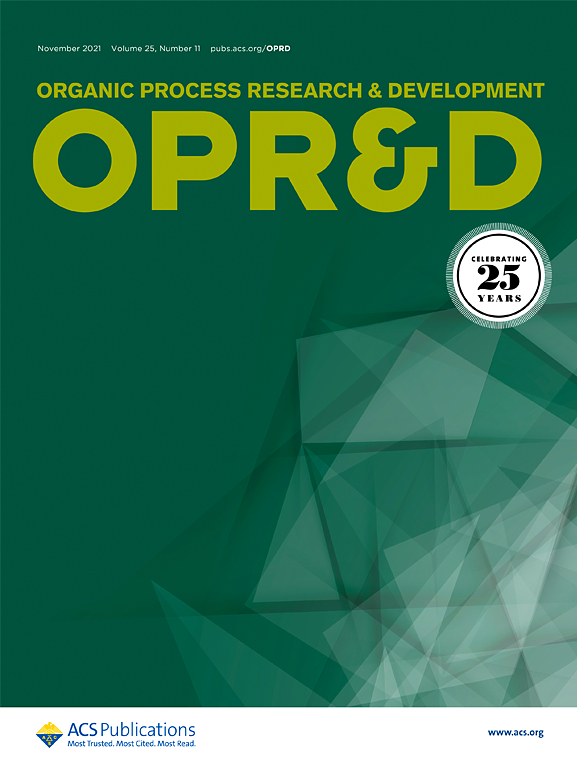Scalable Membrane Enabled One-Pot Liquid-Phase Oligonucleotide Synthesis
IF 3.1
3区 化学
Q2 CHEMISTRY, APPLIED
引用次数: 0
Abstract
In this article, a new one-pot liquid-phase oligonucleotide synthesis (OP-LPOS) route enabled by organic solvent resistant (OSR) ceramic membranes is described. This approach was demonstrated through the synthesis of 6mer and 18mer 2’-OMe phosphorothioate oligonucleotides with high stepwise filtration yields (97–100%), and high crude purity (∼72% for 18mer) using just 1.5 equiv of phosphoramidites. Ceramic organic solvent nanofiltration (OSN) and ultrafiltration (OSU) membranes were used to selectively retain the growing oligonucleotide, which is reversibly tethered to a 4-arm branched PEG support, facilitating lower molecular weight reaction byproducts to permeate to waste. This is the first application of ceramic ultrafiltration membranes in such an application, which enables purification of intermediate products in just 5 diavolumes with high permeance (13 Lm–2 h–1 bar–1). We employ a one-pot approach that integrates sequential coupling, sulfurization, and detritylation steps, followed by a single membrane purification step per chain extension cycle. Analysis of the methodology indicates that the homogeneous reactions and separation performance, which use commercially available reagents and highly scalable membrane systems, represent a promising alternative to solid-phase oligonucleotide synthesis (SPOS) for large-scale manufacturing of therapeutic oligonucleotides. Furthermore, the combination of OP-LPOS with membrane separation increases intermediate product purity and yield. It reduces the number of unit operations, cycle times, and process mass intensity (PMI) compared to the previous state-of-the-art membrane-based LPOS.

可扩展膜支持一锅液相寡核苷酸合成
本文介绍了一种利用有机耐溶剂陶瓷膜进行液相寡核苷酸合成(OP-LPOS)的新途径。该方法通过合成6mer和18mer 2 ' -OMe磷硫代寡核苷酸得到了证明,该方法具有高逐步过滤率(97-100%)和高粗纯度(18mer为72%),仅使用1.5等量的磷酰胺。采用陶瓷有机溶剂纳滤(OSN)和超滤(OSU)膜选择性保留生长的寡核苷酸,并将其可逆地拴在四臂支链PEG载体上,促进低分子量反应副产物渗透到废物中。这是陶瓷超滤膜在此类应用中的首次应用,它可以在5双体积内以高渗透率(13 Lm-2 h-1 bar-1)净化中间产物。我们采用一锅方法,整合了顺序偶联,硫化和脱三烷基化步骤,然后是每个链延伸循环的单个膜净化步骤。方法分析表明,均相反应和分离性能,使用市售试剂和高度可扩展的膜系统,代表了一个有前途的替代固相寡核苷酸合成(SPOS)大规模生产治疗性寡核苷酸。此外,OP-LPOS与膜分离相结合,提高了中间产物的纯度和收率。与之前最先进的基于膜的LPOS相比,它减少了单元操作的数量、周期时间和过程质量强度(PMI)。
本文章由计算机程序翻译,如有差异,请以英文原文为准。
求助全文
约1分钟内获得全文
求助全文
来源期刊
CiteScore
6.90
自引率
14.70%
发文量
251
审稿时长
2 months
期刊介绍:
The journal Organic Process Research & Development serves as a communication tool between industrial chemists and chemists working in universities and research institutes. As such, it reports original work from the broad field of industrial process chemistry but also presents academic results that are relevant, or potentially relevant, to industrial applications. Process chemistry is the science that enables the safe, environmentally benign and ultimately economical manufacturing of organic compounds that are required in larger amounts to help address the needs of society. Consequently, the Journal encompasses every aspect of organic chemistry, including all aspects of catalysis, synthetic methodology development and synthetic strategy exploration, but also includes aspects from analytical and solid-state chemistry and chemical engineering, such as work-up tools,process safety, or flow-chemistry. The goal of development and optimization of chemical reactions and processes is their transfer to a larger scale; original work describing such studies and the actual implementation on scale is highly relevant to the journal. However, studies on new developments from either industry, research institutes or academia that have not yet been demonstrated on scale, but where an industrial utility can be expected and where the study has addressed important prerequisites for a scale-up and has given confidence into the reliability and practicality of the chemistry, also serve the mission of OPR&D as a communication tool between the different contributors to the field.

 求助内容:
求助内容: 应助结果提醒方式:
应助结果提醒方式:


